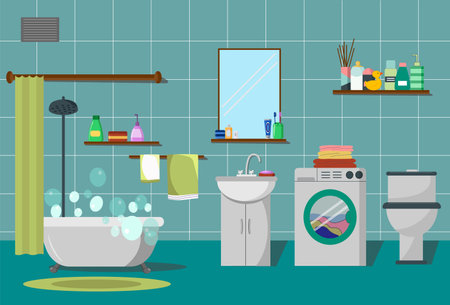Setting Your Vision: Designing a Modern Retreat
Before swinging a hammer or picking out tiles, every successful bathroom renovation starts with a clear vision. Transforming your standard bathroom into a walk-in shower and tub oasis begins by exploring inspiration and defining what “retreat” means to you. In American homes, comfort meets style—think spa-inspired serenity blended with everyday practicality.
Create a mood board using apps like Pinterest or physical swatches. Gather images of walk-in showers, soaking tubs, and sleek vanities that resonate with your taste. Pay attention to trending color palettes—earthy neutrals, bold black accents, or calming blues—and choose hues that make your space feel fresh yet inviting. Don’t forget must-have features like rainfall showerheads, built-in benches, or frameless glass doors that elevate both function and luxury.
By curating these elements, you’ll lay the foundation for a cohesive design plan tailored to American lifestyles—where relaxation and utility go hand in hand. Let your imagination guide you as you reimagine your bathroom into a personal sanctuary.
2. Space Planning: Maximizing Function in Your Layout
Before you pick out tile samples or dream up spa vibes, step back and assess your current bathroom layout. Strategic space planning is the secret sauce for transforming a standard bath into a walk-in shower and tub oasis—without making it feel cramped or chaotic.
Evaluate Your Existing Footprint
Measure your bathroom’s length and width. Take note of door swings, window placements, and existing plumbing locations. These details are crucial when envisioning how both a walk-in shower and a soaker tub can coexist comfortably.
Smart Layout Solutions
| Layout Challenge | Design Solution |
|---|---|
| Narrow Bathroom | Place the tub along one wall; install a glass-walled walk-in shower at the opposite end to keep sight lines open. |
| Square-Shaped Room | Create a wet zone by grouping the shower and tub together behind a single glass partition, maximizing floor space elsewhere. |
| Obstructive Windows/Doors | Opt for freestanding tubs that fit under windows; consider sliding doors to free up usable space. |
Embrace Built-In Storage
Clever built-ins—like recessed niches for shampoo bottles or floating vanities—reduce clutter and visually expand the room. Prioritize vertical storage to keep essentials within reach yet out of sight.
Pro Tip: Think Flow, Not Just Fit
A well-designed oasis guides you seamlessly from shower to tub without tight corners or awkward bottlenecks. Use open shelving, clear glass, and consistent flooring to unite the space. Ultimately, smart planning lets you enjoy both luxury features without sacrificing function or style.

3. Demolition and Prep: What to Expect
Demolition is where your bathroom transformation truly begins, setting the stage for your new walk-in shower and tub oasis. Before swinging the first hammer, it’s crucial to understand the timeline. Typically, demo and prep take anywhere from a few days to over a week, depending on the size of your bathroom and any unforeseen issues hiding behind walls or under floors.
Best Practices for Safe and Efficient Demolition
Start by shutting off water and electricity to the bathroom—safety first. Remove all personal items, towels, and décor to keep them dust-free. If you’re doing it yourself, invest in quality safety gear: gloves, goggles, sturdy shoes, and a mask. Take care to minimize damage to areas that will remain untouched; use plastic sheeting or painter’s tape to seal off doorways and vents to contain dust. When removing fixtures like vanities or old tubs, work slowly and methodically—avoid damaging plumbing or wiring that will be reused.
Protecting Your Home During Renovation
The messy part of renovation doesn’t have to spill into the rest of your home. Lay down drop cloths in hallways and entry points leading to your bathroom. Consider using zippered dust barriers if you’re concerned about fine particles drifting into other rooms. Keep windows open when possible for ventilation, or use fans to direct dust outside.
Plan Ahead for Surprises
Old bathrooms often hide surprises—mold, outdated wiring, or unexpected plumbing needs. Build extra time into your schedule for these potential hiccups. Keeping a flexible mindset can help you navigate challenges without feeling overwhelmed. Remember, thorough prep now leads to a smoother install later—and brings you one step closer to your dream spa retreat at home.
4. Selecting American-Made Materials and Finishes
Choosing the right materials is the foundation of a successful bathroom renovation—especially when you’re transforming your space into a walk-in shower and tub oasis. Opting for American-made tiles, fixtures, and finishes not only supports local craftsmanship but also ensures quality that meets everyday demands. Here’s how to make selections that blend durability with timeless American style.
Durable Tiles: Style Meets Strength
Tiles set the tone for your bathroom’s visual story. Porcelain and ceramic tiles made in the USA are known for their resilience against moisture and wear. Consider subway tiles for a classic look or large-format porcelain for a sleek, modern vibe. Always check slip-resistance ratings, especially for the shower floor, to keep safety top of mind.
Fixture Selection: Quality That Lasts
Fixtures are more than just functional—they’re design statements. Look for brands celebrated for American engineering and craftsmanship. Solid brass or stainless steel fixtures resist corrosion and stand up to heavy use. Choose finishes like brushed nickel or matte black to reflect contemporary trends while keeping maintenance easy.
Finishes Comparison Table
| Finish Type | Best For | Maintenance | Style Note |
|---|---|---|---|
| Brushed Nickel | Everyday Use | Low—hides water spots | Tactile, modern appeal |
| Polished Chrome | High-traffic areas | Medium—shows fingerprints | Crisp, reflective finish |
| Matte Black | Statement Features | Low—resists stains | Sleek, dramatic contrast |
| Oil-Rubbed Bronze | Traditional Looks | Medium—requires gentle cleaning | Warm, vintage feel |
Why American-Made?
Selecting U.S.-manufactured products means you’re investing in proven durability and supporting responsible production standards. Many American brands offer extended warranties and customer support, giving extra peace of mind as you enjoy your new sanctuary.
The right materials and finishes will transform your bathroom renovation into a true oasis—a space where everyday function meets enduring design rooted in American values.
5. Walk-In Shower & Tub Installation: Key Steps
Preparation and Demolition
The transformation begins with a clean slate. Carefully remove existing fixtures, tiles, and flooring. Protect your home by sealing off the work zone and properly disposing of debris. Check for any structural issues before moving forward—this is your chance to address them.
Waterproofing Essentials
A watertight foundation is non-negotiable. Install a high-quality waterproof membrane on floors and walls, especially around the shower pan and tub surround. Overlap seams, seal corners meticulously, and allow proper curing time. This step is crucial for preventing leaks and mold growth long-term.
Plumbing Adjustments
Update supply lines and drainage to accommodate your new walk-in shower and tub layout. Relocate plumbing fixtures as needed for optimal function and flow. In older homes, replacing galvanized pipes with modern materials can prevent future headaches. Always use licensed plumbers to ensure compliance with local codes.
Framing & Support
Reinforce walls and subfloor where needed, particularly if you’re installing a heavier soaking tub or stone tile. Proper blocking supports grab bars or glass enclosures later on. This structural work sets the stage for both safety and style.
Tiling & Finishes
Select slip-resistant tiles for the floor, continuing up the walls for visual cohesion. Precision in cutting and grouting delivers a seamless look. Opt for contemporary, easy-to-clean surfaces that echo your design vision while standing up to daily use.
Building Codes & ADA Compliance
Consult your local building department to ensure every phase meets city regulations—especially electrical outlets, ventilation, and water-tight barriers. For greater accessibility, follow ADA guidelines: zero-threshold showers, lever handles, seating options, and strategic grab bar placement provide comfort for all ages and abilities.
Final Inspections & Quality Checks
Schedule required inspections before closing up walls or connecting fixtures. Test waterproofing integrity, verify correct plumbing slope, and confirm everything functions flawlessly. This attention to detail safeguards your investment—and your peace of mind.
6. Adding Functional Details and Finishing Touches
Once the foundation of your new walk-in shower and tub oasis is set, it’s time to focus on the functional details that make all the difference. Built-in shelving is a staple in American bathroom design—think recessed niches for shampoos, soaps, and even greenery. These shelves maximize space and keep surfaces clutter-free, reflecting a clean, modern aesthetic.
Lighting is another game-changer. Swap out basic fixtures for dimmable LED sconces or sleek pendant lights that provide both task and ambient lighting. Consider backlit mirrors for a touch of luxury that’s as practical as it is stylish. Good lighting not only elevates the mood but also enhances safety and usability, especially in shared family spaces.
To complete your spa-inspired retreat, incorporate finishing touches like rainfall showerheads, thermostatic controls, and heated towel racks. Add a teak bench or built-in seat inside the shower for comfort and accessibility—a nod to inclusive American design principles. Finish with plush towels, aromatic candles, and thoughtful hardware selections in matte black or brushed nickel for a cohesive, curated look.
With these functional details and finishing touches, your bathroom isn’t just renovated—it’s transformed into an inviting sanctuary tailored to American lifestyles and sensibilities.
7. Final Checks: Inspection and Maintenance Essentials
Now that your bathroom transformation is complete, it’s time for the all-important final checks. Ensuring your new walk-in shower and tub oasis meets safety standards isn’t just about peace of mind—it’s about protecting everyone who steps into your space. Schedule a professional inspection to verify that plumbing, electrical systems, ventilation, and waterproofing meet local codes. Pay special attention to slip-resistant flooring, secure grab bars, and properly sealed glass enclosures.
Routine Maintenance for Lasting Beauty
To keep your renovation fresh and functional, establish easy maintenance routines. Wipe down tiles and glass doors daily to prevent soap scum buildup. Clean grout lines weekly with a gentle cleaner to avoid mildew. Inspect caulking around tubs and showers every few months, replacing it at the first sign of wear or cracking.
Don’t Forget the Details
Test all fixtures and drains regularly to catch leaks early. Replace water filters in showerheads as recommended by the manufacturer. Check ventilation fans to ensure they’re working efficiently—good airflow helps prevent mold and keeps your oasis smelling clean.
Your Oasis, Your Responsibility
A well-maintained bathroom isn’t just beautiful; it’s safer and more comfortable for everyday living. By staying proactive with inspections and upkeep, you’ll preserve the function and style of your walk-in shower and tub retreat for years to come.

